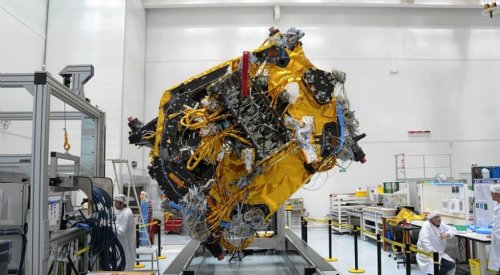WASHINGTON — The Italian Space Agency has launched a new initiative to strengthen Italy’s space expertise by leveraging domestic companies to build spacecraft that complement pan-European programs.
Italian Space Agency President Giorgio Saccoccia said the Ital-GovSatCom satellite contract announced July 23 inaugurates an initiative to create “mirror programs” where Italy provides its own supplemental spacecraft to European Commission-led programs.
The Italian Space Agency, or ASI, tasked Thales Alenia Space Italy with leading a consortium of domestic companies to build Ital-GovSatCom, a communications satellite that will provide capacity for other nations as part of the European Commission’s Governmental Satellite Communications program.
“We foresee what we call ‘mirror programs’ for Galileo, Govsatcom and Copernicus,” Saccoccia said in an interview. “The occasion of Ital-GovSatCom is the first of a possible series that will use those resources from Italy that will mirror initiatives at the European level.”
Saccoccia said ASI signed a contract with Thales Alenia Space in early July for Ital-GovSatCom as part of Italy’s Space Economy initiative. Italy’s goal with “Space Economy” is to pool funding and talent on national and regional levels to support an increase in space projects, he said.
“The idea is to go the extra mile and have a chance to use the best technologies that we have built up in our country,” Saccoccia said. “It’s important to give the opportunity to our companies to get better experience in working on more programs. If we have the resources and see opportunity for return, we see it as useful to invest in development of a specific satellite that can contribute to a larger scope than something done in isolation.”
ASI used a new procurement approach for Ital-GovSatCom, Saccoccia said. The 300 million euro ($334.3 million) project is financed 50% through government resources and 50% through the private sector, he said. That includes 12 regional governments and the autonomous province of Trento, according to ASI.
Saccoccia said ASI is seeking a budget increase to support a larger number of space activities, both for national programs and those it participates in with the 22-nation European Space Agency.
ASI’s total budget, including for ESA contributions, is between 800 and 900 million euros, Saccoccia said. He declined to give a specific amount. Saccoccia said he hopes to finalize a budget increase for ASI’s ESA contribution ahead of ESA’s ministerial conference this November.
Saccoccia cited the ASI’s PRISMA hyperspectral imaging satellite as an example of the kind of technological know-how the agency wants to nurture. OHB Italia built PRISMA with an imaging payload from Leonardo. The satellite launched on an Italian Vega rocket in March.
ASI has one of its experts participating in the review of Vega’s July 10 launch failure, Saccoccia said. The failure review board, which includes Arianespace, Vega manufacturer Avio, and the French and European space agencies, is still investigating the cause.
ASI also wants Ital-GovSatCom to launch on a Vega rocket, specifically the upgraded Vega C, after the satellite is ready five years from now. To compensate for the selection of a relatively small launcher — Vega’s primary market is in low Earth orbit, not the geosynchronous belt where Ital-GovSatCom is to operate — Ital-GovSatCom will use electric propulsion, Saccoccia said.
The use of electric propulsion will optimize the satellite’s weight so that it fits on Vega C, though the 2,500-kilogram satellite will require more time to complete orbit raising. Saccoccia did not give a timeframe for orbit raising. Electrically propelled satellites dropped off in geostationary transfer orbits take months to reach their final orbital slots, as opposed to days when using chemical propulsion.
Saccoccia said the European Commission’s Copernicus Earth observation program is a strong candidate for ASI’s next mirror program. The space agency is also exploring new initiatives in 5G, optical communications, satellite servicing and space situational awareness, he said.
Saccoccia said Italy is willing to help other nations develop their own satellites for Govsatcom as well. The European Defence Agency began a pooling demonstration in January using satellite capacity from its member states. Saccoccia said Italy is providing capacity through the Athena Fidus satellite it operates with France.
- Top Pentagon official Mike Griffin proposes new space agency that ‘disrupts’ traditional procurement
- SN Military.Space | Who’s who in the national security space workforce • Doubts raised about cost of Space Force • U.S., Brazil to share space data
- SN Military.Space | Space Force a political football • The next big thing in space missile defense • How to make satellites ‘defendable’
- SN Military.Space | Space reorganization: Reform fatigue already? • SMD Symposium underway in Huntsville • DARPA soon to announce Blackjack winners
- #SpaceForce takes Capitol Hill by storm • What is the true cost of space programs? • Space budget deep dive
Share with your friends

(0) Comments
This article comments are currently no :(